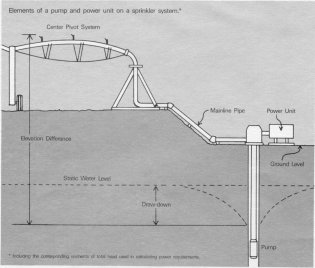
- Home
- Managing An Irrigation System
- Planning System Hardware
- Farm Irrigation Systems & Cost Analysis
- Water Resource Development
- Micro Irrigation Handbook
- Related Links
Efficient Irrigation Planning
Elevation Considerations
Larry M. Curtis, Extension Agricultural Engineer
Ted W. Tyson, Extension Agricultural Engineer
One of the basic requirements of an irrigation system is that it carry water from its source to the desired field locatio'n. If the field is higher than the water source, energy, in the form of fuel, electricity, etc., must be consumed to lift the water from its source to the final location. The greater the elevation difference, the greater the energy required to move the water, and the higher the cost.
Pumping Pressure
One acre-inch of water (the amount of water required to cover 1 acre with 1 inch) weighs 113 tons. This weight must be picked up and moved to the desired location. A pump must develop pressure to move water. For every pound of pressure (reported in pounds per square inch, or psi) developed, water can be lifted 2.31 feet. The energy required to pump the water depends on the total pressure that must be developed and the amount of water (gallons per minute) to be moved. Therefore, the energy required to overcome elevation will depend on the situation that exists in a particular field.
Water Source
There are two basic sources of water. One is surface water (lakes, ponds, streams, reservoirs), and the other is groundwater (wells). For surface water, the elevation difference that must be overcome is the difference between the water level and the sprinkler nozzle or other water-application device at the highest point in the field. As water is used, the water level may decline, increasing the overall elevation difference. The designer of your irrigation system should use the maximum elevation difference when computing horsepower requirements.
Groundwater, or well water, must be lifted from some depth in the well to the highest point in the field. Groundwater comes from water-bearing layers (aquifers) in the ground. These layers are usually composed of sand, gravel, limestone, cracked rock, or a combination of these. When your well is installed, well screens and other construction methods like gravel packing will likely be required to ensure that the well can pump water while preventing sand and other materials from entering the pump.
After a well is installed, water will stabilize at a static level. This is the level that exists when water is not being pumped out. When pumping begins, the water level usually drops, or a draw-down occurs. After some time, if the well has sufficient capacity the draw-down stabilizes and does not drop further. This condition exists when the amount of water flow ing into the well equals the amount of water being pumped out of it. When the draw-down stabilizes, the elevation requirements for your system can be determined. The elevation requirement is the elevation from the draw-down level to the surface plus the elevation difference from the surface to the highest point where water is to be pumped.
When you are planning your well, do as much research as possible. Consult sources like the U.S. Geological Survey and the Alabama Geological Survey to find out what the groundwater potential is in your area and what the likely draw-down will be. Another good source of information is local well drillers. Deal with drillers who have a good reputation and experience in drilling high-capacity wells like city wells, municipal wells, and irrigation wells.
For any given location, there is not much that can be done to decrease the elevation difference between the water supply and the field. About the only thing you can do is use the water supply that has the least elevation difference and, for groundwater use, install a dependable, high-quality well.
In many states where water has been pumped from wells for several years, the level of groundwater is declining. So, the elevation difference increases each year, and the energy required to pump this water becomes greater.

Horsepower Requirement
Remember, computing the difference the elevation of the water source and of the sprinkler nozzles at the highest field is only one step in determining the requirement of an irrigation system. Your pump and power unit must be large enough to force water from the source uphill to the field, produce enough pressure to overcome friction in the pipe and fittings, and operate the system (nozzles or water-application device) at its designed operating pressure.
For further information, consult your county Extension agent, or refer to the following Extension circulars: ANR-545, "Energy And Irrig4tion"; ANR-547, "Energy And Irrigation: Pipe And Fittings"; ANR-548, "Energy And Irrigation: The Pumping Unit"; and ANR-549, "Energy And Irrigation: The Power Unit"
| Publication No.
ANR-546 |
Date
March, 1990 |
Larry M. Curtis, Extension Agriculture Engineer, Professor, Biosystems and Agricultural Engineering, and Ted W. Tyson, Extension Agricultural Engineer, Associate Professor, Biosystems and Agricultural Engineering. |
Issued in furtherance of Cooperative Extension work in agriculture and home economics, Acts of May 8 and June 30, 1914, and other related acts, in cooperation with the U.S. Department of Agriculture. The Alabama Cooperative Extension System (Alabama A&M University and Auburn University) offers educational programs, materials, and equal opportunity employment to all people without regard to race, color, national origin, religion, sex, age, veteran status, or disability.
This document is author-produced (unedited).

 Menu
Menu


